body measurements : ค้นหาหนังสือธรรมะ หน้า 9 / 32
หน้าหนังสือทั้งหมด

22
The Source of Happiness and Peace
Chapter 6
The Source of Happiness and Peace
The differences among beliefs, cultures, customs, nationalities, religions or languages are only superficial external differences. Beneath these difference
Chapter 6 discusses how underlying the superficial differences in beliefs and cultures lies a universal pure nature shared by all humanity. This natural state can be accessed through meditation, leadi

24
Dhamma for Laypersons and the Four Levels of Beauty
A person who has the Dhamma for Laypersons
(Gharāvās-dhamma) must display four regular habits:
1. Habit of Responsibility – Whatever the task at hand, he must do it to the best of his ability, in t
A person who follows the Dhamma for Laypersons exhibits four habits: responsibility, self-training, endurance, and sacrifice. These traits ensure self-reliance and leadership within families. In marri

60
Journey of Spiritual Growth at YUWA CAMP
experience began at 8 at YUWA CAMP. With great happiness, she could see the crystal ball as big as a football and as bright as the mid-noon sun at the center of her body. It was larger and covered her
This narrative follows a young girl whose life transforms after attending YUWA CAMP at the age of 8. She experiences a vivid connection to a crystal ball symbolizing her inner self, which leads to dai

18
กระบวนการขึ้นทะเบียนมรดกโลก ณ เมซอายนาค
Interactive map of Mes aynak
กระบวนการขึ้นทะเบียนมรดกโลก
1. ทำ Tentative List โดน State Party
2. State party คัดเลือก Site ที่จะส่ง เข้าพิจารณา
3. ส่งข้อมูลให้ Advisory Body
4. ICOMOS WCU
5. ส่งถึงค
กระบวนการขึ้นทะเบียนมรดกโลกสำหรับสถานที่เช่น เมซอายนาคเริ่มต้นจากการจัดทำ Tentative List โดย State Party ก่อนที่จะมีการคัดเลือก Site ที่สำคัญ หลังจากนั้นข้อมูลจะถูกส่งให้กับ Advisory Body ที่รวมถึง IC

39
Interpretations of Dhammakāya in Early Pāli Texts
Gombrich, while differently translating the term in this passage as a bahubbiha compound 'dhamma-bodied,' similarly interprets it as an indication that the Buddha's true import is due to 'his teaching
This text delves into various scholars' interpretations of the term 'dhammakāya' within the context of early Pāli suttas. Gombrich views it as 'dhamma-bodied,' emphasizing that the essence of the Budd

54
Understanding Dhamma and Brahman in Buddhism
In the case that 'brahma-' refers to the neuter 'brahman'
In the other case in which the term brahma- is translated as 'brahman'63 the ultimate,64 the third parallel65 suggests that the term dhamma in
This text clarifies that the term 'brahma-' can refer to either the masculine 'Brahmā' or the neuter 'brahman,' ultimately leading to the view that dhamma signifies transcendental realities. It sugges

68
Dhammakāya and Noble Disciples
VI. Reference 3: Dhammakāya and Noble Disciples
Besides the term’s relation to the Buddha and Paccekabuddhas, a Pāli canonical reference mentions also the relation of dhammakāya with noble disciples.
In the context of Pāli texts, the term dhammakāya is linked to noble disciples as evidenced in the story of Gotamī, the great nun and Buddha's foster mother. As she approaches her passing, Gotamī refl

78
Understanding Dhammakāya in Early Theravādin Context
The research approach employed in the present study is intended as a more direct, analytical and inclusive one than previous approaches to this question. It is more direct in that it set off by docume
This study analyzes the term dhammakāya through close readings of Pali canonical passages, revealing that it relates not only to the Buddha but also to other noble figures like Paccakabuddhas and disc

101
Understanding the Pāli Verses and Buddhist Doctrine
The Text
The first nine leaves are inscribed with Pāli verses and a commentary in Tai Yuan.4 The final leaf of the manuscript is an addendum, inscribed with a stanza of the Dvatiṃsa-mahāpuruśa-lakkhaṇ
The manuscript presents Pāli verses and commentary in Tai Yuan, summarizing Buddhist doctrines about the Buddha's physical body and wisdom. It includes thirty stanzas highlighting qualities like divin

121
The Influence of An Shigao on Mindfulness Breathing Meditation in Eastern Han China
In this paper I explore the connections between An Shigao and the introduction of the Indian Buddhist meditation technique of mindfulness breathing meditation, or ānāpānasmṛti, into Eastern Han China.
This paper examines An Shigao's role in introducing the Indian mindfulness breathing meditation technique, ānāpānasmṛti, into Eastern Han China. The phrase「息中具有四大。 而心在中」suggests that the mind should f

48
The Trumpet's Silence and the Body's Concomitants
they stood it upright, they stood it topsy turvy, they struck it with their hands, with a cloud, with a stick, with a sword, on one side, on the other, on every side, saying : - " Speak, master trumpe
This passage illustrates a conversation between a trumpeter and some border born men who are puzzled by the trumpet's silence. The trumpeter reflects on how the instrument requires a person and effort
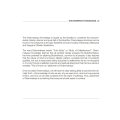
61
Understanding Dhammakaya Knowledge
The Dhammakaya Knowledge is taught by the Buddha to constitute the transcendental, blissful, eternal, and pure Self of the Buddha. Dhammakaya doctrines can be found in the scriptures of all major Budd
Dhammakaya Knowledge is a profound teaching from the Buddha that emphasizes the transcendental, blissful, and pure nature of self. This concept is integral to all major Buddhist schools, including The
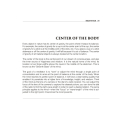
83
Center of the Body: Balance and Mindfulness
CENTER OF THE BODY
Every object in nature has its center of gravity, the point where it keeps its balance. For example, the center of gravity for a cup is at the center point of the cup; the center of
Every object has its center of gravity, maintaining balance. For humans, the center is located two finger-widths above the navel, called the ‘Seventh Base’ of the mind. Meditators aim to focus their m
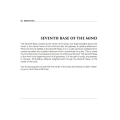
84
The Seventh Base of the Mind
80 MEDICATION
SEVENTH BASE OF THE MIND
The Seventh Base, located at the center of the body, two finger-breadths above the navel, is the natural home of the mind and also the gateway to spiritual att
The Seventh Base is located two finger-breadths above the navel and is essential for the mind's tranquility. It serves as a protective shelter from mental impurities. This center is crucial for achiev
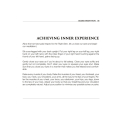
99
Guided Meditation for Achieving Inner Experience
GUIDED MEDITATION 95
ACHIEVING INNER EXPERIENCE
(Now that we have paid respect to the Triple Gem, let us close our eyes and begin our meditation.)
Sit cross-legged with your back upright. Put your
This meditation guide provides instructions on how to achieve a tranquil inner experience. It emphasizes the importance of posture, relaxation of muscles, and gentle closing of the eyes. Participants
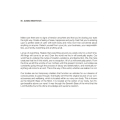
100
The Path to Inner Calm and Awareness
Make sure there are no signs of tension anywhere and that you're closing your eyes the right way. Create a feeling of ease, happiness and purity. Feel that you're entering upon a perfect state of calm
This text encourages a deep sense of calm by detaching from worldly concerns and realizing the temporary nature of existence. It highlights the importance of the Seventh Base of the Mind, an integral

101
Gentle Mindfulness Practice
Now, I’d like to invite all of you to settle your mind at the center of your body. Do it with a soft and gentle attention, an attention so soft and gentle that it is like a bird’s feather floating dow
This text invites readers to cultivate a gentle mindfulness practice by focusing their attention softly at the center of their body. It emphasizes the importance of a light and tender approach, likeni
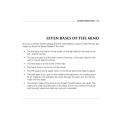
115
Guided Meditation: The Seven Bases of the Mind
GUIDED MEDITATION 111
SEVEN BASES OF THE MIND
Now let us refresh the Knowledge that the Great Master Luang Pu Wat Paknam has taught us about the Seven Bases of the mind.
- The first base is at the
In this guided meditation, we revisit the teachings of the Great Master Luang Pu Wat Paknam regarding the Seven Bases of the Mind. The first base is located at the rim of the nostril, the second at th

131
Mindfulness and Relaxation Techniques
Close your eyes softly and gently. Relax every part of your body. Don’t let any part of your body be tense.
Leave the habit of using your eyes to look into your tummy to see images. Close your eyes g
บทความนี้สอนวิธีการทำสมาธิและการผ่อนคลายผ่านการหลับตาและการบรรเทาความตึงเครียดในร่างกาย โดยเฉพาะการแนะนำให้หลับตาและใช้จินตนาการในจิตใจแทนการมองเห็นภาพภายในร่างกาย เน้นว่าทุกอย่างเกิดจากจิตใจ ไม่ใช่จา

132
Understanding Your Body's Signals in Practice
Your body will tell you whether you’re doing the right thing or not. If your eyebrows twist, or your eyes, your forehead and your body become tense, or you feel tedious, discouraged, and the time seem
ร่างกายของคุณจะบอกว่าคุณทำสิ่งที่ถูกต้องหรือไม่ หากคิ้วของคุณบิดหรือรู้สึกเครียด นั่นบ่งบอกว่ามีบางอย่างไม่ถูกต้อง จึงไม่ควรบังคับตัวเอง ต้องปรับแนวทางและเริ่มใหม่หลายครั้งจนกระทั่งคุณรู้วิธีปรับร่างก
